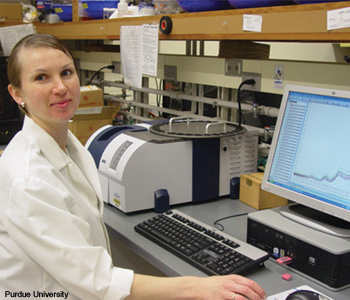Scatterings
Spectroscopic Test for Killer Chemical
Now, a Purdue University (West Lafayette, Ind., U.S.A.) team has figured out a way to detect trace levels of a harmful contaminant with devices that many law enforcement laboratories already own.
 Purdue graduate student Alona A. Chernyshova works on her lab’s near-infrared spectrometer.
Purdue graduate student Alona A. Chernyshova works on her lab’s near-infrared spectrometer.
In the past two years, pet foods and milk products contaminated with the organic chemical melamine have harmed children in China and domestic animals in multiple countries. Now, a Purdue University (West Lafayette, Ind., U.S.A.) team has figured out a way to detect traces of melamine powder with devices that many law enforcement laboratories already own.
…Log in or become a member to view the full text of this article.
This article may be available for purchase via the search at Optica Publishing Group.
Optica Members get the full text of Optics & Photonics News, plus a variety of other member benefits.
